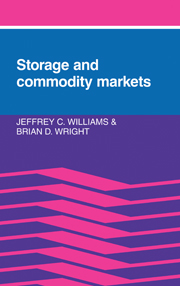Book contents
- Frontmatter
- Contents
- Preface
- Acknowledgments
- 1 Introduction
- Part I The basic model
- Part II Implications of storage for research on time series
- Part III Extensions of the model
- 8 The market's reaction to news
- 9 The interaction of storage and trade
- 10 Inventories of raw materials, finished goods, and goods in process
- 11 Market power and storage
- Part IV Public interventions
- Part V Epilogue
- References
- Author index
- Subject index
9 - The interaction of storage and trade
Published online by Cambridge University Press: 03 February 2010
- Frontmatter
- Contents
- Preface
- Acknowledgments
- 1 Introduction
- Part I The basic model
- Part II Implications of storage for research on time series
- Part III Extensions of the model
- 8 The market's reaction to news
- 9 The interaction of storage and trade
- 10 Inventories of raw materials, finished goods, and goods in process
- 11 Market power and storage
- Part IV Public interventions
- Part V Epilogue
- References
- Author index
- Subject index
Summary
The storage studied in previous chapters is a form of intertemporal arbitrage, in a closed economy. Economists have given incomparably greater attention in research, teaching, and policy advice to another type of arbitrage, namely, intratemporal trade among open economies. What new lessons can be learned about trade and storage when both arbitrage activities are possible?
This chapter shows the fruitfulness of a combined approach. We show how storage weakens the “law of one price” and how it reduces the destabilizing effects of trade barriers in markets buffeted by random shocks. In a meaningful sense, storage has significant advantages over trade as a stabilization mechanism. Our theoretical model offers instructive rules on equilibrium international distribution of stocks. National storage responds in quite different ways to world prices and availability compared to its response to domestic availability. And FOB–CIF price bands are dubious guides to notions of national equilibrium price, given world prices.
In the basic storage model of previous chapters, the closed system could be a single country isolated by prohibitively high shipping costs or a worldwide market in which all countries are effectively combined because shipping costs are negligible. This chapter covers the intermediate case in which two countries are open to trade but the cost of shipping is not zero. This system too is closed as a whole, but within it trade is free in the sense of having no legal proscriptions, though transport costs are positive. There is a market for the commodity in each country. The amount traded and the prices in the two countries are endogenous.
- Type
- Chapter
- Information
- Storage and Commodity Markets , pp. 229 - 272Publisher: Cambridge University PressPrint publication year: 1991



